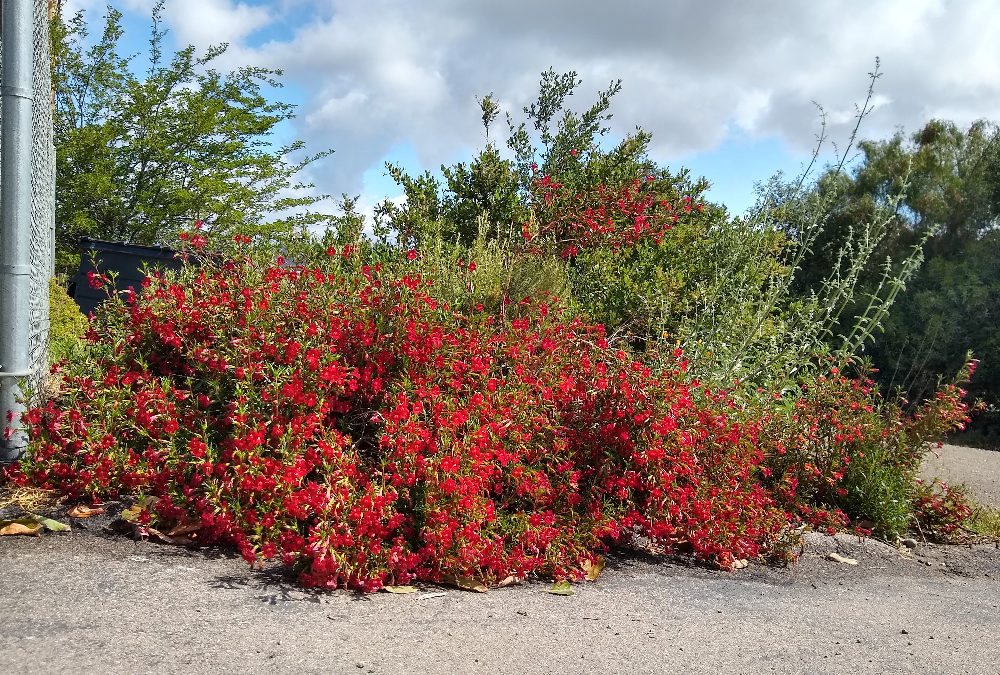Monkey flowers dot the hills of Southern California in the spring with their yellow, orange, and red flowers. They’re natives; they grow wild here.
Monkey flowers also grow along the road in front of my house, but these ones were planted by me. Nevertheless, they feel at home and thrive. I give them zero irrigation or other care and they still put out heaps of flowers and feed the nearby wildlife.
Most times I get close to my monkey flowers I find honey bees disappearing inside their tubular blooms and emerging with pollen on their backs.

I also find native bees. But as you might guess, since the flowers are tubular they are suited for the long, narrow bills of hummingbirds. Having red flowers doesn’t hurt either (for those monkey flowers that are red), as hummingbirds are said to be particularly attracted to that color. (Darn it, I haven’t been able to get a good photo of a hummingbird on the monkey flowers though.)
Looking closely at one of the flowers, you can imagine a monkey’s face, if that is why the plant earned that name. Looking closely, you also notice a two-parted, white stigma in the center. And someone recently told me that if you touch this stigma, it reacts to your touch and clasps shut. I tried it. It’s true.

You can read about the effects of this curious behavior of monkey flower stigmas here.
Sometimes the plant is also called “sticky” monkey flower because its leaves are . . . sticky. And you can find it called “bush” monkey flower. Of course, fancy people call it by its botanical name: Mimulus aurantiacus. Or is it Diplacus aurantiacus? Taxonomists battle over this plant. (Have to justify their jobs, right?)
According to maps on Calscape, monkey flowers can be found in the wild up and down the entire California coast. Lucky for me, they truly proliferate in my neighborhood in the foothills of San Diego County.
Here’s a short video of a couple of my monkey flowers:
Moosa Creek Nursery grows monkey flowers, as does Las Pilitas, if you’re interested in buying a plant. Monkey flowers can also be grown from cuttings and seed.
The Nature Collective has a good profile on monkey flowers, if you’d like to learn more about them.
For a list of flowers that feed bees (and other helpful insects and birds) all year round in Southern California, see this post.
All of my Yard Posts are listed HERE




I live in SD in Claremont. Are there any nurseries close to me to purchase the Monkey flower? I do have plants that bees gravitate to but my apricot trees had lots of blooms but hardly any fruit on them now. I think it is a lack of bees. Want to plant something under the trees that will draw the bees near. I have a veg garden with a few mums but I should add some flowers to bring the bees also. Any recommendations?? Thank you
Hi Andrea,
I would visit Walter Andersen’s nursery over near Point Loma, as they sell Moosa Creek plants and should be able to get a monkey flower for you.
See these posts about different flowers to bring the bees:
https://gregalder.one/yardposts/flowers-for-bees-all-year-in-southern-california/
https://gregalder.one/yardposts/growing-a-bee-garden/
Hello, I was able to buy a beautiful red monkey flower from Home Depot in Clairemont- they are currently carrying both orange and berry varieties.
Best wishes,